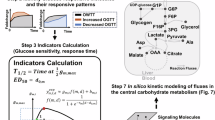Abstract
IN this mild controversy it is worth recalling that Somogyi1 long ago found that the total glycolytic activity of sheep blood is only 20–30 per cent of that of human blood. Leng and Annison2 have recently shown that glucose only in rare cases penetrates into sheep erythrocytes. But they also observed that of the low glucose metabolism which does take place in these red cells 15 per cent goes through the pentosephosphate pathway; when stimulated by methylene blue, the fraction rises to nearly 100 per cent. These findings implicate the presence of glucose-6-phosphate dehydrogenase in the cells, but the concentration is clearly so low that it escapes detection with the rather crude methods we use for convenience in our surveys of human populations. This particular feature of sheep red cells is probably only another aspect of the peculiar carbohydrate metabolism in these animals.
This is a preview of subscription content, access via your institution
Access options
Subscribe to this journal
Receive 51 print issues and online access
$199.00 per year
only $3.90 per issue
Buy this article
- Purchase on SpringerLink
- Instant access to full article PDF
Prices may be subject to local taxes which are calculated during checkout
Similar content being viewed by others
References
Somogyi, M., J. Biol. Chem., 103, 665 (1933).
Leng, R. A., and Annison, E. F., Austral. J. Agric. Res., 13, 31 (1962).
Author information
Authors and Affiliations
Rights and permissions
About this article
Cite this article
BUDTZ-OLSEN, O., AXTEN, B. & HAIGH, S. Estimation of Glucose-6-phosphate Dehydrogenase in Sheep Erythrocytes. Nature 201, 718–719 (1964). https://doi.org/10.1038/201718b0
Issue date:
DOI: https://doi.org/10.1038/201718b0



